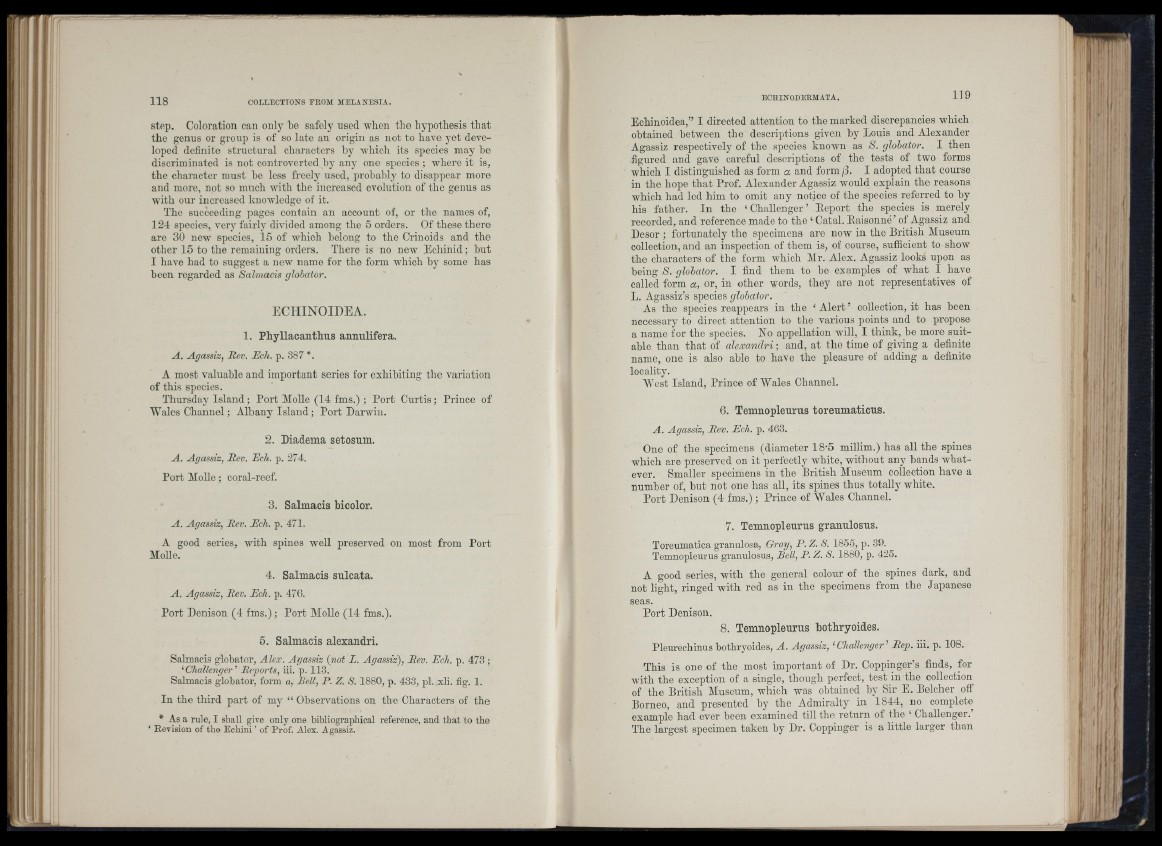
step. Coloration can only be safely used -wben tho hypothesis that
the genus or group is of so late an origin as not to have j’et developed
definite structural characters by which its species may he
discrimiuated is not controverted by any one species ; whore it is,
the character must he less freely used, probably to disappear more
and more, not so much with the increased evolution of the genus as
with our increased knowledge of it.
The succeeding pages contain an account of, or the names of,
124 species, very fairly diidded among the 5 orders. Of these there
are 30 new species, 15 of which belong to the Orinoids and the
other 15 to the remaining orders. There is no new Echinid; but
I have had to suggest a new name for tho form which by some has
been regarded as Salmacis ghhator.
ECHINOIDEA.
1. Phyllacanthus annulifera.
A. Agassiz, Rev. Ech. p. 387 *.
A most valuable and important series for exhibiting the variation
of this species.
Thursday Is la n d ; Port Molle (14 fms.) ; Port Cu rtis; Prince of
A\*ales Channel; Albany Island ; Port Darwin.
2. Diadema setosum.
A. Agassiz, Rev. Ech. p. 274.
Port Molle; coral-reef.
3. Salmacis hicolor.
A. Agassiz, Rev. Ech. p. 471.
A good series, with spines well preserved on most from Port
Molle.
4. Salmacis sulcata.
A. Agassiz, Rev. Ech. p. 470.
Port Denison (4 fms.); Port Molle (14 fms.).
5. Salmacis alexandri.
Salmacis glohator, Alex. Agassiz {not L. Agassiz), Rev. Ech. p. 473;
‘Challenger’ Reports, iii. p. 113.
Salmacis glohator, form a, Bell, P. Z. S. 1880, p. 433, pi. xli. fig. 1.
In the third part of my “ Observations on the Characters of the
* As a rule, I shall give only one bibliographical reference, and that to the
‘ Revision of the Echini ’ of Prof. Alex. Agassiz.
Echinoidea,” I directed attention to the marked discrepancies which
obtained between the descriptions given by Louis and Alexander
Agassiz respectively of the species known as S. glohator. I then
figured and gave careful descriptions of the tests of two forms
which I distinguished as form a and form /3. I adopted th a t course
in the hope th at Prof. Alexander Agassiz would explain the reasons
which had led him to omit any notice of the species referred to by
his father. In the ‘ Challenger ’ Ecport the species is merely
recorded, and reference made to the ‘ Catal. Paisonne’ of Agassiz and
Desor ; fortunately the specimens are now in the British Museum
collection, and an inspection of them is, of course, sufficient to show
the characters of the form which Mr. Alex. Agassiz looks upon as
being S. glohator. I find them to be examples of what I have
called form a, or, in other words, they are not representatives of
L. Agassiz’s species glohator.
As the species reappears in the ‘ Alert ’ collection, it has been
necessary to direct attention to the various points and to propose
a name for the species. No appellation will, I think, be more suitable
than th at of alexandri; and, at the time of giving a definite
name, one is also able to have the pleasure of adding a definite
locality.
West Island, Prince of Wales Channel.
6. Temnopleurus toreumaticus.
A. Agassiz, Rev. Ech. p. 463.
One of the specimens (diameter 18-5 millim.) has all the spines
which are preserved on it perfectly white, without any hands whatever.
Smaller specimens in the British Museum collection have a
number of, but not one has all, its spines thus totally white.
Port Denison (4 fms.) ; Prince of Wales Channel.
7. Temnopleurus granulosus.
Toreumatica granulosa, Gray, P. Z. S. 1855, p. 39.
Temnopleurus granulosus, Bell, P. Z. S. 1880, p. 425.
A good series, with the general colour of the spines dark, and
it light, ringed with red as in the specimens not ringi from the Japanese
seas.
Port Denison.
8. Temnopleurus hothryoides.
Pleiirechinus hothryoides, A. Agassiz, ‘Challenger’ Bep. iii. p. 108.
This is one of the most important of Dr. Coppinger’s finds, for
with the exception of a single, though perfect, test in the collection
of the British Museum, which was obtained by Sir E. Belcher off
Borneo, and presented by the Admiralty in 1844, no complete
example had ever been examined till the return of tho ‘ Challenger.
The largest specimen taken by Dr. Coppinger is a little larger than
I'M